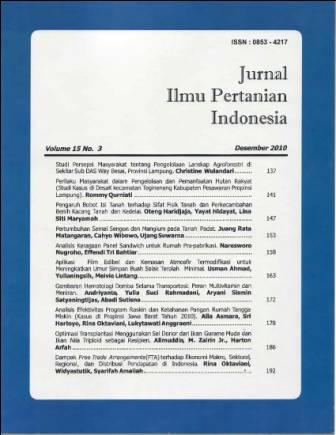Pengaruh Bobot Isi Tanah Terhadap Sifat Fisik Tanah Dan Perkecambahan Benih Kacang Tanah Dan Kedelai (Effect Of Soil Bulk Density On Soil Physical Properties And Seed Germinations Of Peanut And Soybean)
Abstract
Soil physical properties can affect to seed germination and plant growth. Soil compaction will degrade soil physical properties which in term will affect to root penetration and developement in the soil. The improvements of soil physical properties is required to ensure seed germination and plant growth such as treatment to maintain soil bulk density is quite low. The purpose of this research is to study the influence of soil compaction (soil bulk density) to soil physical characteristics and seed gemination of peanuts and soybean. This research used Jasinga Podsolik soil, conducted at Soil Physical Laboratory, Departement of Soil Science and Land Resources, Faculty of Agriculture IPB. and Greenhouse of Center of Biological Resources and Biotechnology, Research and Community Service Agency, IPB (March-November 2009). Completed random design was used as experimental design and Duncan's Multiple Range Test (DMRT) was used to identify the effect of treatment. The bulk density result of the research showed that the increasing of soil bulk density (soil compaction) had significantly affect on pF curves, permeability rate, and soil resistance before or after planting. For peanuts, soil compaction significantly affect to plant height and root length. Soil compaction did not significantly affect of stem diameter, number of leaves, canopy or root biomass. For soybean, the influence of soil compaction did not significantly affect just only on plant height. Stem diameter, number of leaves, root length or root and canopy biomasses were not affected by soil compaction.Downloads
References
Damanik, P. 2007. Perubahan kepadatan tanah dan produksi tanaman kacang tanah akibat intensitas lintasan traktor dan dosis bokasi. Skripsi. Departemen Teknik Pertanian. Fakultas Teknologi Pertanian. Institut Pertanian Bogor
Fikriati, M. 2010. Uji daya hasil lanjutan kedelai toleran naungan di bawah tegakan karet rakyat di Kabupaten Sorolangun, Jambi. Departemen Agronomi dan Hortikulura. Fakultas Pertanian. Institut Pertanian Bogor.
Hardjowigeno, S. 2002. Ilmu Tanah. Jakarta: Akademika Presindo.
Mattjik, A. A., Made Sumertajaya. 2002. Perancangan percobaan dengan aplikasi SAS dan Minitab Jilid I. Bogor: IPB PRESS
Mualim, L. 2007. Tanggap morfologi, fisiologi, dan anatomi akar serta tajuk tanaman terhadap pemadatan tanah. Sekolah Pascasarjana. Institut Pertanian Bogor.
Ningsih, W. 2007. Evaluasi senyawa fenolik pada biji, kecambah dan tempe kacang tunggak. Skripsi. Departemen Teknologi Industri Pertanian. Fakultas Teknologi Pertanian. Institut Pertanian Bogor.
Pamungkas, M.Y. 2004. Pengaruh tingkat kepadatan tanah terhadap pertubuhan tanaman dan karakteristik umbi lobak. Skripsi. Departemen Teknik Pertanian. Fakultas Teknologi Pertanian. Institut Pertanian Bogor.
Satyagraha, H. 2005. Optimasi proses pengolahan dan karakterisasi produk serta penentuan umur simpan beras ubi kayu yang disubsidi dengan kecambah kedelai. Skripsi. Fakultas Teknologi Pertanian. Institut Pertanian Bogor.
Simanjuntak, R.H. 2005. Pengaruh pemberian BO, kapur, dan belerang terhadap produksi biomasa, kadar serapan belerang pada tanaman jagung (Zae mays) di tanah podsolik, Jasinga. Skripsi. Tanah. Fakultas Pertanian. Institut Pertanian Bogor
Wilson, E. 2006. Kepadatan tanah akibat penyaradan oleh forwarder dan pengaruhnya terhadap pertumbuhan semai. Skripsi. Departemen Hasil Hutan. Fakultas Kehutanan. Institut Pertanian Bogor
www.wikipedia.com. 2010. Syarat tumbuh tanaman kedelai. Akses tanggal 20 Januari 2010.
This journal is published under the terms of the Creative Commons Attribution-NonCommercial 4.0 International License. Authors who publish with this journal agree to the following terms: Authors retain copyright and grant the journal right of first publication with the work simultaneously licensed under a Creative Commons Attribution-NonCommercial 4.0 International License. Attribution — You must give appropriate credit, provide a link to the license, and indicate if changes were made. You may do so in any reasonable manner, but not in any way that suggests the licensor endorses you or your use. NonCommercial — You may not use the material for commercial purposes.


















